

Креативная коммуникация: методы и инструменты. Психолингвистика (Psycholinguistics) How We Remember War and Violence: Theory and Practice from FutureLearn. Media Literacy and Representation from FutureLearn. Creative Thinking: Techniques and Tools for Success from edX. Module 1 In the first module we focus on the basic principles of creativity and highlight its importance in tackling global challenges.

Creativity is explored and applied at two different levels, lower and higher-level creativity. Throughout, we're aiming to provoke your thoughts and develop your creative mind through varied activities and interactions. Module 2 In this module, we will look at how we can augment our creativity using different methods of Brainstorming, a creativity approach that aids the generation of ideas in solving a stated problem. The Power of Podcasting for Storytelling from FutureLearn. Learn English Online: Beginner to Advanced Language Courses. Online Courses From Top Universities. Join for Free. Information and Communication Technology (ICT) Accessibility. Programa del curso.
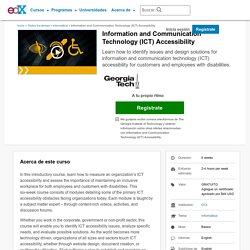
How to Write an Essay. Terrorism and Counterterrorism. Terrorism has gone from a persistent yet marginal security concern to one of the most important security problems of our day.
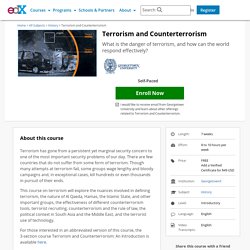
There are few countries that do not suffer from some form of terrorism. Though many attempts at terrorism fail, some groups wage lengthy and bloody campaigns and, in exceptional cases, kill hundreds or even thousands in pursuit of their ends. This course on terrorism will explore the nuances involved in defining terrorism, the nature of Al Qaeda, Hamas, the Islamic State, and other important groups, the effectiveness of different counterterrorism tools, terrorist recruiting, counterterrorism and the rule of law, the political context in South Asia and the Middle East, and the terrorist use of technology. For those interested in an abbreviated version of this course, the 3-section course Terrorism and Counterterrorism: An Introduction is available here. Terrorism and Counterterrorism. Terrorism and Counterterrorism: An Introduction.
How Media Got Social. How to Write a Novel: Edit & Revise. Course Syllabus Skip Syllabus Description Every Week Learners will read writing examples, watch instructor videos and view interviews with published authors, editors and agents.

Each week will include at least one assignment, a group discussion topic and instructor feedback in the form of video responses to questions related to that week’s assignments during live office hours on Google Hangouts.Week 1: Preparing to Rewrite First, we’ll introduce students to the elements of the course, expectations, and what they can hope to accomplish. We’ll discuss acceptable behaviour in feedback and discussion boards.
The substantive edit The line edit The copy edit Finally, we’ll discuss how a writer evaluates what they have, and how to get started with the rewriting process. Assignment: We’ll ask you to analyze the scenes in your draft with an eye to each scene’s essential elements, building up a simple tool to help you visualize your entire novel’s structure. Global Media, War, and Technology. The Writing Process. Writing for Social Media. How to Write a Novel: Structure & Outline. Course Syllabus Skip Syllabus Description edX: UBCx – CW1.1x.
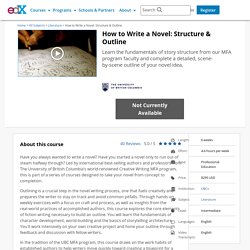
Instructors: Nancy Lee and Annabel Lyon University of British Columbia Creative Writing Program Outlining is a crucial step in the novel writing process, one that fuels creativity and prepares the writer to stay on track and avoid common pitfalls. Through hands-on weekly exercises with a focus on craft and process, as well as insights from the real- world practices of accomplished authors, this course explores the core elements of fiction writing necessary to build an outline. You'll work intensively on your own creative project and hone your outline through feedback and discussion with fellow writers.
In the tradition of the UBC MFA program, this course draws on the work habits of established authors to help writers move quickly toward creating a blueprint for a successful draft. Every Week Students will watch instructor videos, interviews with authors and readings. Week 1: Getting Started. A History of Violence: From the Middle Ages to Modern Times. Programa del curso Skip Syllabus DescriptionWeek 1: The Nature of Violence Theories of ‘pure’ hunter gathers, primates as model for hunter-gather behaviour, anthropology, and evolutionary psychology will be examined as a basis for the origins of violence.
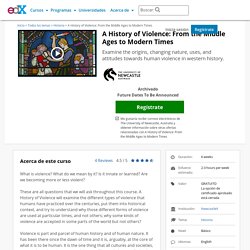
We will explore early records from rock art and archaeological discoveries.Week 2: Intimate and Gendered Violence Violence in the intimacy of the family, usually committed by men against women and children, but also against slaves and servants, has been a constant throughout history. How to Write a Novel: Writing the Draft. Course Syllabus Skip Syllabus Description Every Week Learners will read writing examples, watch instructor videos and view interviews with published authors.
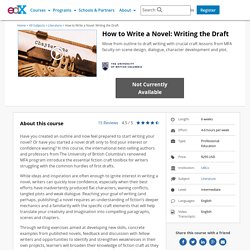
Each week will include at least one assignment, regular group discussion topics and instructor feedback in the form of video responses to questions related to that week’s assignments during live office hours on Google Hangouts. Week 1: Introduction / The Aesthetic Journey. The Ethics of Memory. What is memory?
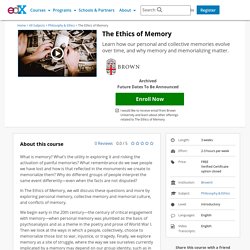
What’s the utility in exploring it and risking the activation of painful memories? What remembrance do we owe people we have lost and how is that reflected in the monuments we create to memorialize them? Why do different groups of people interpret the same event differently—even when the facts are not disputed?